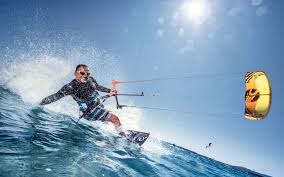Those hot summer days are usually great for hitting the waves with a surfboard, but sometimes the wild is just completely wrong, too strong or just spoils the waves completely. Luckily, there’s an alternative that actually depends on the wild and makes a whole new style of surfing possible.
 It doesn’t matter if you’d like to just surf over the water in style or if you want to go extreme and see just how high the kite can take you, kite surfing has the perfect opportunity for everyone! Introduced around the mid-90’s, kite surfing started out as a rather dangerous sport as the gear didn’t really work with stronger winds and the surfer simply didn’t have much control over the speed and what the kite was doing, not to mention, the safety gear we use today simply didn’t exist back them.
It doesn’t matter if you’d like to just surf over the water in style or if you want to go extreme and see just how high the kite can take you, kite surfing has the perfect opportunity for everyone! Introduced around the mid-90’s, kite surfing started out as a rather dangerous sport as the gear didn’t really work with stronger winds and the surfer simply didn’t have much control over the speed and what the kite was doing, not to mention, the safety gear we use today simply didn’t exist back them.
Today, it’s a completely different sport that includes much better gear and allows the rider to take advantage of the windy days, irrespective of how strong the winds are. A kite surfing kit consists of various items, ranging from the actual kite through to the safety gear that makes the whole experience much easier. Below, we look at the most important things you’ll need to hit the water on those windy days and discover a whole new range of excitement!
Buying Your Kite
Kites are available in various sizes and styles, starting from as little as 5 meters through to a massive 20 meters and even bigger. The size would depend on your weight and the wind strength where you’ll be surfing, which could be tricky as speeds aren’t always the same.
Therefore, most end up with a kit consist of 2 kites of different sizes, such as a 9 meter for the strong wind days and a 12 meter for the days that are windy but don’t have enough power for the smaller kite. Sure, most would think buying a bigger kite is better, but it’s important that you get the right size as a kite that’s too big would be overpowering and end up yanking you around when it’s gusty.
Get a Board
Boards are available in 3 styles, including twin tip, surf style and foil boards. The twin tip is the best to start with as it allows you to change direction easily without having to turn around. Surf style of directional boards are basically surfboards that have been changed in a few ways to make it better suited for kite surfing. Finally, hydrofoil boards are the latest and require the most experience as you’ll actually be surfing above the water. They are the best for light wind days as they have a lot less resistance in comparison to the other options.
Safety Gear
You’ll have to get a decent harness as this keeps you attached to the kite. There are two options, including a kidney belt and a seat harness, which is basically like shorts you’ll be wearing. It’s also important to use a decent safety system that allows you to detach from the kite if anything happens and you need to release it. These are also attached to the harness and allow riders to take control during those sticky situations.